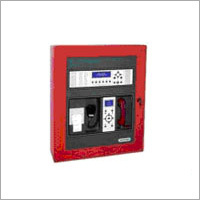
Fire Alarm Panel Installation
Product Details:
Product Description
A fire alarm control panel (FACP), or fire alarm control unit (FACU), is an electric panel that is the controlling component of a fire alarm system. The panel receives information from environmental sensors designed to detect changes associated with fire, monitors their operational integrity and provides for automatic control of equipment, and transmission of information necessary to prepare the facility for fire based on a predetermined sequence. The panel may also supply electrical energy to operate any associated sensor, control, transmitter, or relay. There are four basic types of panels: coded panels, conventional panels, addressable panels, and multiplex systems. A fire alarm control panel is required under the building code for a majority of new commercial building construction in most countries.
Conventional Fire panel
Conventional panels have been around ever since electronics became small enough to make them viable. They are no longer used frequently in large buildings, but are still used on smaller sites such as small schools, stores, restaurants, and apartments.
A conventional system employs one or more initiating circuits, connected to sensors (initiating devices) wired in parallel. These sensors are devised to decrease the circuits resistance when the environmental influence on any sensor exceeds a predetermined threshold. In a conventional system the information density is limited to the number of such circuits used. A small map of the building is often placed near the main entrance with the defined zones drawn up, and LEDs indicating whether a particular circuit/zone has been activated. Another common method is to have the different zones listed in a column, with an LED to the left of each zone name. Examples include the Edwards 6500 and the Simplex 4005 or 4006.
Adderesable Fire Panel
Addressable panels are usually much more advanced than their conventional counterparts, with a higher degree of programming flexibility and single point detection. Addressable fire alarm panels were introduced by many manufacturers during the microcontroller boom in the mid 1980s. Examples include the Simplex 4100U and the Notifier Onyx.
Signaling Line Circuit Loops
Panels usually have a number of signaling line circuit loops - usually referred to as loops or SLC loops - ranging between one and thirty. Depending on the protocol used, a loop can monitor and control several hundred devices. Some protocols permit any mix of detectors and input/output modules, while other protocols have 50% of channel capacity restricted to detectors/sensors and 1/2 restricted to input/output modules. Each SLC polls the devices connected, which can number from a few devices to several hundred, depending on the manufacturer. Large systems may have multiple SLCs, and SLCs are further divided into sub-groups through the use of fault-isolation modules.
Each device on a SLC has its own address, and so the panel knows the state of each individual device connected to it. Common addressable input (initiating) devices included.
Other Products in 'Fire Alarm Panel Installation' category
Branch Office:
Shop No - 2, Ist Floor, Ganpati Plaza,
Bass Road, Dharuhera - 122106, Haryana
Phone: +91-1274-242096
Head Office:
Plot No. - 857, Bye Pass Road,
Jhajjar - 124103, Haryana
Phone: +91-1251-253245.
|
|
|
|
 |
VENUS AUTOMATION SECURITY SYSTEM
All Rights Reserved.(Terms of Use) Developed and Managed by Infocom Network Private Limited. |



